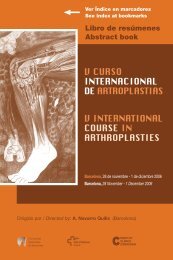Notas / Notes - Active Congress.......
Notas / Notes - Active Congress.......
Notas / Notes - Active Congress.......
Create successful ePaper yourself
Turn your PDF publications into a flip-book with our unique Google optimized e-Paper software.
MARTES / TUESDAY<br />
42<br />
HIP RESURFACING FOR<br />
OSTEONECROSIS<br />
Harlan C. Amstutz, MJ Le Duff<br />
Joint Replacement Institute,<br />
Los Angeles (USA)<br />
INTRODUCTION<br />
The results of THA and prior hip resurfacing designs with<br />
Polyethylene in osteonecrosis (ON) have been less satisfactory<br />
than for patients with other etiologies. Metal-on-metal<br />
(MM) resurfacing is bone preserving and stable and permits<br />
a wide selection of revision options for young patients.<br />
METHODS<br />
From a cohort of 1000 hips of all etiologies, 84 hips (70 patients,<br />
avg. age 40.1 years), with ON Ficat Stage III (19 hips)<br />
and IV (65 hips) were treated with hybrid MM resurfacing.<br />
81% were males and 19% female. 33.3% had previous surgeries<br />
including core decompressions (17 hips), hemi-resurfacing<br />
arthroplasty (3 hips), pinning (5 hips), free vascularized<br />
fibula graft (2 hips) and Judet graft (1 hip). 71 hips (85%)<br />
presented femoral head defects larger than 1cm and none<br />
were excluded because of the size of the defect.<br />
RESULTS<br />
The average F/U was 6.2 years (1.5-11). Average femoral<br />
component size was 46.3mm. The clinical scores were comparable<br />
to that of the rest of the cohort except for the activity<br />
score which was lower in average (7.0 vs.7.5, p=0.0015).<br />
Three hips were revised: 2 for femoral loosening at 22 and<br />
61 months, and one for a fracture of the acetabular wall (over<br />
reaming in osteopenic bone) with protrusio of the cup one<br />
day post surgery. There were no other complications. X-ray<br />
analysis revealed 3 cases of neck narrowing (1 bilateral) and<br />
2 cases of femoral radiolucencies in 3 zones around the<br />
metaphyseal stem. The Kaplan-Meier 5-year survival estimate<br />
was 97.1% (95% Confidence Interval 88.7 to 99.2). There<br />
has been no femoral component loosening for patients implanted<br />
after August of 1997.<br />
CONCLUSION<br />
Our results highlight that the etiology of osteonecrosis itself<br />
does not constitute a contraindication for resurfacing despite<br />
large defects. Technique is critical in achieving initial femoral<br />
fixation and promoting long-term durability. Those patients<br />
who had large defects are advised to refrain from impact<br />
activities.<br />
AVASCULAR NECROSIS AND HIP<br />
RESURFACING<br />
Michael Menge, Clemens Nitschke<br />
St. Marienkrankenhaus,<br />
Ludwigshafen (Germany)<br />
BACKGROUND<br />
Osteonecrosis (AVN) of the femoral head very often affects<br />
patients between the age of 20 and 50 years of age. In many<br />
cases conservative treatment will not be sufficient and<br />
arthroplasty has to be performed. As in these mostly younger<br />
patients life expectancy will be normal it may be helpful using<br />
a resurfacing device first to keep standard total hip replacement<br />
as a second chance procedure.<br />
Method: Between 1999 and 2006 more than 1.500 patients<br />
received a MoM resurfacing of the hip. From those patients<br />
35 patients received a resurfacing for a stage four posttraumatic<br />
or localized AVN. We excluded patients with metabolic<br />
disorders or continued steroid medication. There were<br />
two additional cases of sickle cell anaemia. The technique<br />
in these cases will be described and the problems will be<br />
discussed.<br />
RESULTS<br />
The intraoperative findings and the technique will be demonstrated.<br />
Mostly the neck of the femur will have to be shortened<br />
significantly. Lateralizing the acetabular socket can partially<br />
retain the offset. Only two patients had to be revised due to<br />
neck fracture according to progressive necrosis.<br />
CONCLUSIONS<br />
In our limited series of AVN treated with resurfacing of the<br />
hip the outcome was better than in standard hip THR. In<br />
about 6% the osteonecrosis progressively lead to a neck<br />
fracture and to conversion to a standard stem with big head<br />
metal to metal articulation.<br />
RESURFACING IN THE<br />
ELDERLY PATIENT<br />
Michael Menge<br />
St. Marienkrankenhaus,<br />
Ludwigshafen (Germany)





